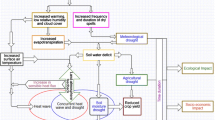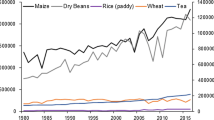Abstract
As the global climate changes, different degrees of variation in climatic factors will have various impacts on agricultural production, leading to appropriate or stressed conditions. The impact threshold of climate change (ITCC) for agriculture refers to the value of a climatic factor at which the agricultural status mutates. Due to the urgency of addressing the negative impacts of climate change on agriculture, research on the ITCC of agriculture is crucial. Here, we built models to reflect the relationship between agricultural climate yield and climatic factors based on climate change characteristics and objective agricultural status. Using the models, we obtained the appropriate and stressed thresholds of different climatic factors. We calculated the ITCC of spring wheat in Wuchuan County as an example and identified warming and drying trends in Wuchuan County from 1961 to 2013, especially during the period from 1991 to 2013 (i.e., the period after mutation or the change period). Over the past 53 years, spring wheat yield increased with an average rate of 81.3 kg ha−1 dec−1. Over the change period, however, yield decreased with an average rate of 13.8 kg ha−1 dec−1 and the fluctuation range increased. The appropriate threshold for average temperature during the growth period of spring wheat was 11.4 °C, and the stressed thresholds were 8.2 and 14.6 °C. The appropriate threshold for precipitation during the growth period was 391.1 mm, and the stressed thresholds were 247.4 and 534.9 mm. During the period before mutation (i.e., the basic period), the average temperature was below the upper temperature threshold, and precipitation was 26.9 mm above the lower precipitation threshold. During the change period, the average temperature was 0.3 °C above the upper temperature threshold, and precipitation was 9.8 mm above the lower precipitation threshold.






Similar content being viewed by others
References
Brissona N, Gate P, Gouache D, Charmet G, Oury F, Huard F (2010) Why are wheat yields stagnating in Europe? A comprehensive data analysis for France. Field Crop Res 119(1):201–212. https://doi.org/10.1016/j.fcr.2010.07.012
Calderini D, Slafer G (1998) Changes in yield and yield stability in wheat during the 20thcentury. Field Crop Res 57(3):335–347. https://doi.org/10.1016/S0378-4290(98)00080-X
Dai J, Bean B, Brown B, Bruening W, Edwards J, Flowers M, Karow R, Lee C, Morgan G, Ottman M, Ransom J, Wiersma J (2016) Harvest index and straw yield of five classes of wheat. Biomass Bioenergy 85:223–227. https://doi.org/10.1016/j.biombioe.2015.12.023
Dong ZH (1999) Establishing risk management system of agriculture in China. J Zhongnan Univ Financ Econ 2:69–71
Dong ZQ, Pan ZH, An PL et al (2012) Responses of growth period of spring wheat in northern ecotone to climate change: a case of Wuchuan county, Inner Mongolia, China. Adv Clim Chang Res 8(4):265–271
Dong ZQ, Pan ZH, An PL, Wang LW, Zhang JT, He D, Han HJ, Pan XB (2015) A novel method for quantitatively evaluating agricultural vulnerability to climate change. Ecol Indic 48:49–54. https://doi.org/10.1016/j.ecolind.2014.07.032
Dong ZQ, Pan ZH, An PL, Zhang JT, Zhang J, Pan YY, Huang L, Zhao H, Han GL, Wu D, Wang JL, Fan DL, Gao L, Pan XB (2016) A quantitative method for risk assessment of agriculture due to climate change. Theor Appl Climatol 131(1-2):653–659. https://doi.org/10.1007/s00704-016-1988-2
Du HM, Yan JP, Wang PT (2015) The drought disaster and its response to the warming-drying climate in the farming-pastoral ecotones in northern China. J Arid Land Resour Environ 1(1):124–128
Fagre BD, Charles CW, Allen CD, Birkelan, C, Chapin FC, Groffman PM, Guntenspergen GR, Knapp AK, McGuire AD, Mulholland PJ, Peters, DPC, Roby DD, Sugihara G (2009). Thresholds of Climate Change in Ecosystems. US Climate Change Science Program Synthesis and Assessment Product 4.2
Hitz S, Smith J (2004) Estimating global impacts from climate change. Glob Environ Chang 14(3):201–218. https://doi.org/10.1016/j.gloenvcha.2004.04.010
Hou Q, Guo RQ, Yang LT (2009) Climate change and its impact on main crops in Inner Mongolia. Chin J Agrometeorol 30(4):560–564
IPCC (2001) Technical Summary. In: White KS, Ahmad QK, Anisimov O et al (eds) In: Climate Change 2001: Impacts, Adaptation, and Vulnerability. Contribution of Working Group II to the Third Assessment Report of the Intergovernmental Panel on Climate Change. Cambridge University Press, Cambridge
IPCC (2013) Approved Summary for Policymakers. In: Alexander L, Allen S, Bindoff NL et al (eds) Climate Change 2013: The Physical Science Basis Summary for Policymakers. Contribution of Working Group I to the Fifth Assessment Report of the Intergovernmental Panel on Climate Change. Cambridge University Press, Cambridge
Jones RN (2000) Analysing the risk of climate change using an irrigation demand model. Clim Res 14(2):89–100. https://doi.org/10.3354/cr014089
Liu YJ, Tao FL (2012) Probabilistic assessment and uncertainties analysis of climate change impacts on wheat biomass. Acta Geograph Sin 3(3):337–345
Lobell DB, Field CB (2007) Global scale climate-crop yield relationships and the impacts of recent warming. Environ Res Lett 2:1–7
Lobell DB, Schlenker W, Costa-Roberts J (2011) Climate trends and global crop production since 1980. Science 333(6042):616–620. https://doi.org/10.1126/science.1204531
Luo QY, Gao MJ, Jiang WL, Tao T, Tang Q (2010) Study on resources threshold value based on agricultural comprehensive production capability security in China. Res Agric Modern 4(7):392–396
May RM (1977) Thresholds and breakpoints in ecosystems with a multiplicity of stable states. Nature 269(5628):471–477. https://doi.org/10.1038/269471a0
Naylor RL, Battisti DS, Vimont DJ, Falcon WP, Burke MB (2007) Assessing risks of climate variability and climate change for Indonesian rice agriculture. PNAS 104(19):7752–7757. https://doi.org/10.1073/pnas.0701825104
Pan ZH (1996) Study on a dynamic prediction system of spring wheat field soil moisture in Wuchuan dry-land farming area. China Agricultural University, Beijing
Parry M, Rosenzweig C, Livemore M (2005) Climate change, global food supply and risk of hunger. Philos Trans R Soc B 360(1463):2125–2138. https://doi.org/10.1098/rstb.2005.1751
Peltonen-Sainio P, Jauhiainen L, Laurila I (2009) Cereal yield trends in northern European conditions: changes in yield potential and its realisation. Field Crop Res 110(1):85–90. https://doi.org/10.1016/j.fcr.2008.07.007
Pittock AB, Jones RN (1999) Adaptation to what, and why? Environ Monit Assess 61:9–35
Qin J (2000) Relationship between climatic factors and grain production in Yunnan province. Q J Appl Meteorol 11(2):213–220
Qin PC, Yao FM, Cao XX, Zhang JH (2012) Application of risk assessment in evaluation of influence of climate change on agricultural production: review and prospect. J Nat Dis 1(2):39–46
Reyenga PJ, Howden SM, Meinke H, Hall WB (2001) Global change impacts on wheat production along an environmental gradient in south Australia. Environ Int 27(2-3):195–200. https://doi.org/10.1016/S0160-4120(01)00082-4
Studnicki M, Wijata M, Sobczynski G, Samborski S, Gozdowski D, Rozbicki J (2016) Effect of genotype, environment and crop management on yield and quality traits in spring wheat. J Cereal Sci 72:30–37. https://doi.org/10.1016/j.jcs.2016.09.012
Wei FY (1999) Modern climatic statistical diagnosis and prediction technology. China Meteorological Press, Beijing, pp 59–79
Xiao GJ, Zhang Q, Wang J (2007) Impact of global climate change on agro-ecosystem: a review. Chin J Appl Ecol 18(8):1877–1885
Xiong W, Ju H, Xu YL, Lin ED (2006) The threshold of temperature increase due to climate change for Chinese agriculture and its uncertainties. Adv Earth Science 1:70–76
Yang XG, Liu ZJ, Chen F (2010) The possible effects of global warming on cropping systems in ChinaI. The possible effects if climate warming on northern limits of cropping systems and crop yields in China. Sci Agric Sin 43(2):329–336
Zhang ANZ, Pan ZH, An PL, Wang LW, Dong ZQ, He D, Pan XB, Zhao PY (2014) The trend of ecological water shortage of farmland ecosystem in dryland under the background of climate change: a case of Wuchuan County. J Arid Land Resour Environ 10(10):68–75
Acknowledgements
This study was supported by the Non-profit Research Foundation for Meteorology of China (No. GYHY201506016 and GYHY201306038), the National Natural Science Foundation of China (Grant Nos. 41371232 and 41271110), and the National Science and Technology Support Program of China (No. 2012BAD09B02).
Author information
Authors and Affiliations
Corresponding author
Rights and permissions
About this article
Cite this article
Dong, Z., Pan, Z., An, P. et al. A quantitative method for determining the impact threshold of climate change for agriculture. Theor Appl Climatol 135, 425–431 (2019). https://doi.org/10.1007/s00704-018-2397-5
Received:
Accepted:
Published:
Issue Date:
DOI: https://doi.org/10.1007/s00704-018-2397-5




